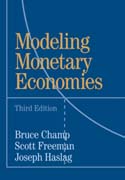
This upper-level undergraduate textbook, now in its second editon, approachesmonetary economics using the classical paradigm of rational agents in a market setting. Too often monetary economics has been taught as a collection of facts about existing institutions for students to memorize. By teaching from first principles, the authors aim to instruct students not only in existing monetary policies and institutions but also in what policies and institutions may orshould exist in the future. The text builds on a simple, clear monetary modeland applies this framework consistently to a wide variety of monetary questions. The authors have added in this second edition new material on speculative attacks on currencies, social security, currency boards, central banking alternatives, the payments system, and the Lucas model of price surprises. Discussions of many topics have been extended, presentations of data greatly expanded,and new exercises added.INDICE: Preface; Part I. Money: 1. A simple model of money; 2. Barter and commodity money; 3. Inflation; 4. International monetary systems; 5. Price surprises; Part II. Banking: 6. Capital; 7. Liquidity and financial intermediation; 8. Central banking and the money supply; 9. Money stock fluctuations; 10. Fully backed central bank money; 11. The payments system; 12. Bank risk; Part III.Government Debt: 13. Deficits and the national debt; 14. Savings and investment; 15. The effect of the National Debt on capital and savings; 16.The temptation of inflation; References; Index.This upper-level undergraduate textbook, now in its second editon, approachesmonetary economics using the classical paradigm of rational agents in a market setting. Too often monetary economics has been taught as a collection of facts about existing institutions for students to memorize. By teaching from first principles, the authors aim to instruct students not only in existing monetary policies and institutions but also in what policies and institutions may orshould exist in the future. The text builds on a simple, clear monetary modeland applies this framework consistently to a wide variety of monetary questions. The authors have added in this second edition new material on speculative attacks on currencies, social security, currency boards, central banking alternatives, the payments system, and the Lucas model of price surprises. Discussions of many topics have been extended, presentations of data greatly expanded,and new exercises added.INDICE: Preface; Part I. Money: 1. A simple model of money; 2. Barter and commodity money; 3. Inflation; 4. International monetary systems; 5. Price surprises; Part II. Banking: 6. Capital; 7. Liquidity and financial intermediation; 8. Central banking and the money supply; 9. Money stock fluctuations; 10. Fully backed central bank money; 11. The payments system; 12. Bank risk; Part III.Government Debt: 13. Deficits and the national debt; 14. Savings and investment; 15. The effect of the National Debt on capital and savings; 16.The temptation of inflation; References; Index.
- ISBN: 978-1-107-00349-1
- Editorial: Cambridge University Press
- Encuadernacion: Cartoné
- Páginas: 376
- Fecha Publicación: 30/04/2011
- Nº Volúmenes: 1
- Idioma: Inglés
